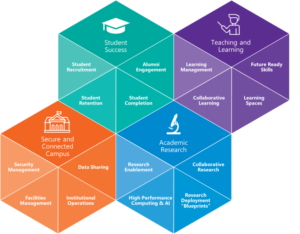By Alexandros Papaspyridis, Director, Higher Education, Asia Pacific Japan
 The United Nations Sustainable Development Goal 4 (SDG4) aims to ensure inclusive and equitable quality education and promote lifelong learning opportunities for all. The role of technology is not only in equipping students with information and communications technology (ICT) skills, but also in achieving quality education, free from the constraints of location and time, and encourage curiosity, creativity, and collaboration. Quality education is, not only, a fundamental human right, but is also linked directly to the financial prosperity of citizens and nations.
The United Nations Sustainable Development Goal 4 (SDG4) aims to ensure inclusive and equitable quality education and promote lifelong learning opportunities for all. The role of technology is not only in equipping students with information and communications technology (ICT) skills, but also in achieving quality education, free from the constraints of location and time, and encourage curiosity, creativity, and collaboration. Quality education is, not only, a fundamental human right, but is also linked directly to the financial prosperity of citizens and nations.
Artificial intelligence (AI) brings the promise of important benefits for education, such as learning that is personalized to the preferences of each student, helping her/him to adapt the pace and control iterations to improve the mastery of the topic. In a survey we conducted with Times Higher Education, University leaders replied that a benefit from AI will be that “AI will be able to assess students, provide feedback and generate and test scientific hypotheses at least as well as humans can”.
Microsoft Research was founded in 1991 with the mission to advance the state of the art of computing, transfer innovative technologies into Microsoft products and incubate for the future. MSR operates eight labs across the world, of which, Microsoft Research Asia (MSRA) in Beijing has celebrated its 20th anniversary.
MSRA is Microsoft’s fundamental research arm in the Asia Pacific region and has published more than 6,000 papers with more than 50 of them being selected as best papers. MSRA has developed a lot of breakthrough AI technologies, such as on Deep Residual Learning in image recognition, speech recognition and text to speech, chatbot engines, etc. and has made important contributions to a wide array of Microsoft products which are used in education solutions as we will see.
In this post, we are addressing three objectives:
-
- Explore the current status of AI in Higher Education
- categorize applications of AI in education using Microsoft’s digital transformation framework for Higher Education and present a number of use cases.
- discuss the AI technologies supporting these innovations
Understanding Opportunities & Challenges
Despite the promise of AI in education, a McKinsey report from 2017 lists education and health care as the sectors with the lowest adoption of AI. To understand the opportunities and challenges around AI in Higher Education, we have conducted two studies.
In March 2019, Microsoft and Times Higher Education released the results of the AI Survey conducted worldwide. Although university leaders agree that AI will be a very significant issue for higher education over the next 10-15 years, only 41% of the institutions surveyed had an AI strategy in place and 43% had budget allocated for such projects. The survey shows that AI will have a big impact beyond Computer Science in fields like medicine and engineering.
In September 2019, Microsoft Asia and IDC Asia/Pacific released findings specific to the education sector for the study, Future Ready Skills: Assessing APAC Education Sector’s Use of AI, where it found that Artificial Intelligence (AI) will help double the rate of innovation improvements for higher education institutions. Based on the study, the top business drivers for education leaders to adopt AI include better student engagement, higher funding, and accelerated innovation.
In this study, we analyzed the current AI readiness across 5 dimensions: Strategy, Investments, Culture, Capabilities, Infrastructure, and Data. Compared to Asia Pacific’s overall AI readiness across all sectors, the educational sector is currently lagging primarily in Data and Culture and secondarily in Strategy and Investments.
The results of these two surveys show that for Higher Education Institutions to reap the benefits of AI they have to accelerate the adoption of a data-driven culture and expose and manage their data estates. This should be followed by putting a strategy in place and committing budget to implement the strategy.
Microsoft Education Transformation Framework (ETF) for Higher Education
The Microsoft ETF for Higher Education provides practical advice to help develop a holistic digital transformation strategy, based on the Institution’s vision and desired outcomes.
Analogous to the ETF for K-12, the Higher Ed ETF focuses on the needs of Tertiary Education and comprises four pillars:
-
-
- Student Success: Attract students, drive student outcomes, and connect with students in lifelong relationships.
- Teaching & Learning: Build an environment that empowers academics to do their best work with personalized learning systems and collaborative spaces that empower students to reach their full potential.
- Academic Research: Empower all researchers with a powerful and flexible computing environment to perform their research without constraints from the underlying infrastructure and collaborate with other researchers across the world.
- Secure & Connected Campus: Reimagine how to configure, optimize and manage campus resources by connecting the physical infrastructure with digital technology to deliver a seamless and modern campus experience.
-
We will examine below a number of case studies in the use of AI technology in each of the ETF pillars.
Student success
MIP Politecnico di Milano Graduate School of Business worked with Microsoft to develop FLEXA, a new digital platform powered by Microsoft Azure and AI which will enable students to assess their professional skills and provide them with personalized content to help fill skills gaps between their career goals and their existing studies.
FLEXA then derives a personalized learning pathway that takes into account this assessment, the amount of time at a student’s disposal and personalized daily workouts and topical exercises. FLEXA is intended to address also the needs of alumni for lifelong learning.
Teaching & Learning
Prof. David Kellermann of University of New South Wales (UNSW) in Sydney embarked on a journey to implement an engaging learning collaboration environment for his engineering class using Microsoft Teams as its backbone and Microsoft Stream for video recording. Prof. Kellermann then implemented a Question Bot (QBot) that assigned student questions to the relevant teaching assistant (TA).
The Q+A pairs that were created were used to build a Knowledge Base so now the bot can answer student questions and also lookup previous answers which may be buried in previous threads. The student can still request to have a TA answer the question. The bot can also search video lecture transcripts and deliver time-stamped video clips to students.
Prof. Kellermann then started putting QR codes on the learning material so when students uploaded a picture of their worksheets, the Question bot could recognize what the student was working on using the Microsoft Custom Vision cognitive service. The use of these technologies helped Prof. Kellermann to create an AI-powered learning community and has been received enthusiastically by the students, with class satisfaction jumping to 99%. Moving to remote learning makes imperative that institutions drive an engaging online community that is available 24×7, with AI freeing teachers from mundane and repetitive tasks. QBot has been open-sourced and is available on GitHub.
As part of Microsoft’s efforts in accessibility, the Immersive Reader is an AI-powered service that helps improve reading and text comprehension for people regardless of their age or ability. read. It uses AI extensively, for example, in language detection, in text-to-speech, translation, etc. The Immersive Reader has been integrated into the Office 365 software suite and the Microsoft Edge browser and is also available as a cognitive service so 3rd party software developers can integrate it in their application.
AI is also used to power teaching foreign language skills. In January 2018, Microsoft Asia Research signed a strategic cooperation agreement with Pearson Group to further deepen the cooperation between AI and English education. Earlier, the two sides jointly launched “LongWen Xiaoying”, an artificial intelligence-driven interactive English learning application. Acquiring foreign language skills cuts across all ages and education levels, from K-12 to Higher Ed and Lifelong Learning.
Reducing assessment effort for simple answers is a great time saver for teaching staff. Microsoft’s partner GamaLearn AI technologies in authoring, proctoring and marking to provide automation, self-based, and personalized assessment. The SwiftAssess AI-Cyber Proctor solution helps institutions ensure exam session integrity on a large scale, with capturing of different compromising events, highlighting session issues, providing forensics dashboards, etc.
Research
A key challenge for every researcher is the explosion of knowledge creation, with the number of academic papers doubling within a decade. In addition, traditional citation metrics are not adequate, as they are quantitative only. Moreover, all citations do not carry equal significance and citation counts have been demonstrated that can be rigged. In addition, bibliographic searches rely on lengthy queries to capture keyword variations and this process has to be repeated across multiple databases. Keyword searches can, therefore, become blinders.
Microsoft Academic (MA) is a Microsoft Research project exploring how to assist academics in conducting scientific research by leveraging the computers’ cognitive power. MA is using natural language processing (NLP) techniques to label each paper discovered by Bing crawler with semantic labels. By analyzing 230 million papers, MA has built a graph of 710K+ semantic labels that have been derived using self-supervised learning. Each paper is ranked by estimating the importance of each entity, such as the authors citing it, using big data and graph analysis. MA also recommends similar papers that do not have a citation relationship.
How does MA help researchers be productive? First, by powering more insightful bibliographic analysis and this has been used to inform the OECD AI Policy Observatory, the Stanford HCAI AI Index report, etc. Second, it helps researchers to reimagine systematic reviews and research literature reviews by acting as an intelligent AI assistant. ePPI and UCL are using AI & MA to reimagine Randomized Control Trials (RCTs). In collaboration with several organizations, Microsoft Academic has been used to identify and bring together worldwide scientific efforts and results for the New Machine Readable COVID-19 Dataset.
Intelligent campus
The University experience can be overwhelming particularly for new and international students who have to navigate a whole set of questions and sources of information. Chatbots utilizing the Microsoft bot framework, help students get their questions answered fast. Griffith University’s Sam helps students find the information they are looking for quickly. The University of Sydney FinBot helps its finance department respond rapidly to questions regarding POs, and other related issues. The University of Canberra developed a student chatbot called Lucy to respond quickly to student inquiries. It is important to note that in the latter two projects, the user can always flag the question to be addressed by a human if the answers provided are unsatisfactory.
Conclusion
Artificial Intelligence (AI) will see an increasingly important role in Higher Education. AI can be used in all four pillars of the Microsoft Education Transformation Framework (ETF) for Higher Education and already Universities across the world are leveraging it. Microsoft Research leadership in AI research has led to a powerful cognitive services framework that lights up bots that answer students’ questions, transcribes and indexes videos with lectures, or uses natural language processing to understand the topic of a paper. In addition, AI research on reinforcement learning can be used to provide personalized experiences to students.
The AI-powered applications will not be replacing teachers but augment and empower them. At the same time, these applications will reduce the time needed for routine tasks allowing faculty to focus on teaching and research.
Acknowledgment
The author would like to thank Dr. Hsiao-Wuen Hon for his valuable feedback on the manuscript.






